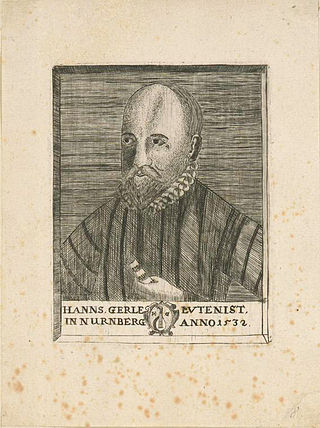Related Research Articles
Giovanni Girolamo Kapsperger was an Austrian-Italian virtuoso performer and composer of the early Baroque period. A prolific and highly original composer, Kapsberger is chiefly remembered today for his lute and theorbo (chitarrone) music, which was seminal in the development of these as solo instruments.
1550 in music involved some significant events.
The decade of the 1530s in music involved some significant events, publications, compositions, births, and deaths.
The decade of the 1540s in music involved some significant events.
The decade of the 1490s in art involved some significant events.

The Lives of the Most Excellent Painters, Sculptors, and Architects, often simply known as The Lives, is a series of artist biographies written by 16th-century Italian painter and architect Giorgio Vasari, which is considered "perhaps the most famous, and even today the most-read work of the older literature of art", "some of the Italian Renaissance's most influential writing on art", and "the first important book on art history".
Massimo Lonardi is an Italian lutenist who actively performs as soloist as well as in several ensembles all over Europe.
This is a list of notable events in music that took place in 1554.

Hans Gerle was a German lutenist and arranger of the Renaissance. Little concrete information is available regarding Gerle's life. His father was probably Conrad Gerle, one of the city's better-known lute makers. Gerle likely spent his entire life in Nuremberg.

Carlo Francesco Pollarolo was an Italian composer, organist, and music director. Known chiefly for his operas, he wrote a total of 85 of them as well as 13 oratorios. His compositional style was initially indebted to the opera tradition of Giovanni Legrenzi and Carlo Pallavicino, but he moved beyond this style with innovations to the compositional structure of the aria characterized by expanded forms and orchestral elaborations. His early work used three part strings in the Legrenzi and Pallacino tradition of orchestration, but his mid and later works had developed into a richer orchestration of five strings parts and expanded instrumentation of brass and woodwinds. He was the first Venetian opera composer and one of the earliest Italian composers to use the oboe in his opera orchestrations.

Girolamo Scotto was an Italian printer, composer, businessman and bookseller of the Renaissance, active mainly in Venice. He was the most influential member of the firm of Venetian printers, the House of Scotto, which existed from the late 15th century until 1615. At its peak in the 1560s, the Scotto firm under Girolamo was one of the preeminent publishing firms of Europe, producing volumes on law, scholasticism, philosophy, medicine, theology, and ancient literature in addition to music. Only the firm of Gardano produced more books of music in the 16th century than the House of Scotto under Girolamo; over half of Scotto's publications, 409 out of approximately 800 in total, were books of music.
References
- ↑ Hannu Annala; Heiki Mätlik: Handbook of Guitar and Lute Composers, Mel Bay Publications, 2007, S. 24
- ↑ Konrad Ragossnig: Handbuch der Gitarre und Laute. Schott, Mainz 1978, ISBN 3-7957-2329-9, S. 36.
- ↑ Douglas A. Smith: A history of the lute from antiquity to the Renaissance, Lute Society of America, 2002, S. 100
Sources
- Oscar Chilesotti Note circa alcuni liutisti italiani della prima metà del Cinquecento (Milan, 1902).
- Geo Pistarino Un episodio della vita di Pietro Paolo Borrono (1949)